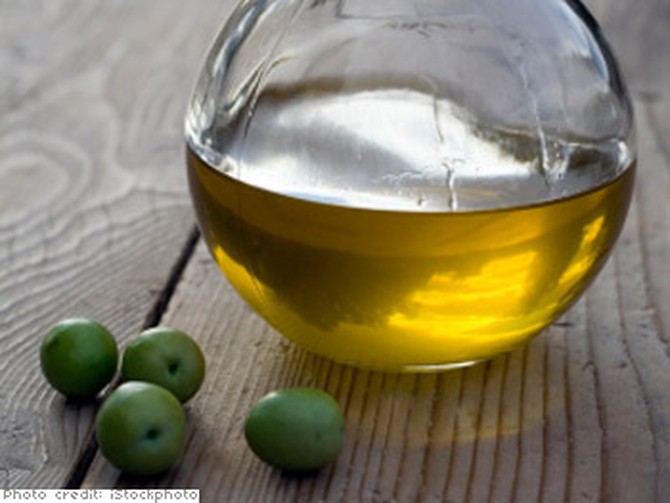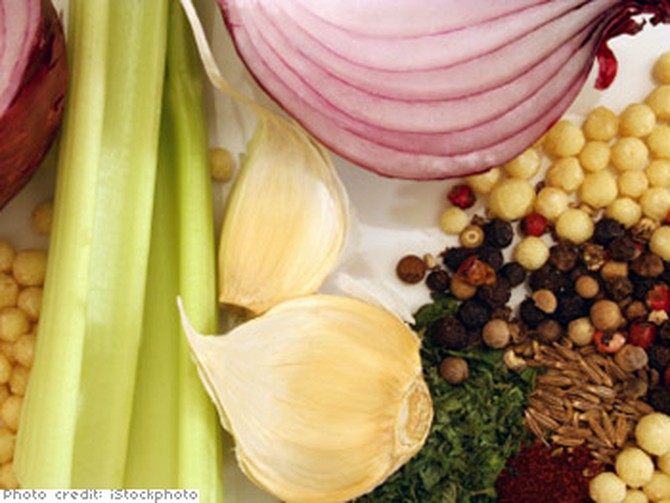Recipe Rescues

Garlic Know-How
Chef Art Smith says garlic is probably the most popular seasoning in everyone's house. The key to making the most of it? Use fresh garlic or no garlic at all!
- If the garlic is sprouted, it's going to be bitter. If it's shriveled, it's not going to taste fresh. It's important when selecting garlic that it has a firm head.
- If it has a light garlic smell, buy it. If it smells too harsh, don't buy it!
- When storing, do not keep it longer than a month, because it will lose flavor. Remember to always keep the garlic in a cool, dry place.

How to Braise Meat
Braising—slow cooking in liquid—is an easy way to tenderize food and to bring out intense, gutsy flavors.
You begin by sautéing—browning the meat in a small amount of oil or butter. (Although you could skip this step if you're in a hurry, it gives both the meat and the pan juices a deep color and rich taste.) Then slowly add a small amount of liquid such as broth, wine or water to the pan—it should reach about halfway up the sides of the meat. Cover the pan tightly to keep in the moisture and heat. Whether you're braising on the stove or in the oven, finish cooking the food at a low temperature by simmering, not boiling, the liquid.
It is good to braise in a heavy six- or eight-quart Dutch oven, which is also excellent for larger cuts of beef, veal or pork. A large skillet or roasting pan can do the job as long as the food is completely covered by the lid.
How do you know when it's done? You should be able to cut the meat with a fork. You can make the dish ahead of time, cover it, and refrigerate it for a couple of days. It's even better reheated.
You begin by sautéing—browning the meat in a small amount of oil or butter. (Although you could skip this step if you're in a hurry, it gives both the meat and the pan juices a deep color and rich taste.) Then slowly add a small amount of liquid such as broth, wine or water to the pan—it should reach about halfway up the sides of the meat. Cover the pan tightly to keep in the moisture and heat. Whether you're braising on the stove or in the oven, finish cooking the food at a low temperature by simmering, not boiling, the liquid.
It is good to braise in a heavy six- or eight-quart Dutch oven, which is also excellent for larger cuts of beef, veal or pork. A large skillet or roasting pan can do the job as long as the food is completely covered by the lid.
How do you know when it's done? You should be able to cut the meat with a fork. You can make the dish ahead of time, cover it, and refrigerate it for a couple of days. It's even better reheated.

How to Peel and De-Vein Shrimp
Use fresh shrimp, or fresh frozen shrimp. The shell should have a crispness to it and shouldn't feel slimy (the older the shrimp, the soggier the shell).
To peel, place your thumb under the shell where the legs meet, and unwrap the shrimp one section at a time. To remove the vein, place a paper towel on a cutting board. Lay the shrimp on the paper towel with the inside curve facing you.
Using your finger, press gently on top of the shrimp. With a paring knife, make a gentle cut, only about an eighth-inch deep, along the outside curve of the shrimp, starting at the head and ending at the tail. With the tip of the knife, help the vein out of the flesh at one end of the shrimp. Then, with the tip of the knife, hold the vein down on the paper towel and pull the shrimp away.
To peel, place your thumb under the shell where the legs meet, and unwrap the shrimp one section at a time. To remove the vein, place a paper towel on a cutting board. Lay the shrimp on the paper towel with the inside curve facing you.
Using your finger, press gently on top of the shrimp. With a paring knife, make a gentle cut, only about an eighth-inch deep, along the outside curve of the shrimp, starting at the head and ending at the tail. With the tip of the knife, help the vein out of the flesh at one end of the shrimp. Then, with the tip of the knife, hold the vein down on the paper towel and pull the shrimp away.

Sifting Flour
The packaging on flour often says that it is pre-sifted, but Art Smith says don't pay any attention to that! And, he says he always re-measures his flour after sifting. It does make a difference.
Don't use measuring cups for liquids when measuring flour either. The measuring cups for dry ingredients will give you a more accurate amount. Baking requires exact measurements for the best results. Always spoon the flour into the measuring cups and skim off the excess with a knife.
Art says many people in the South sift their flour three or four times to make sure the flour is light. Light flour makes light biscuits.
Don't use measuring cups for liquids when measuring flour either. The measuring cups for dry ingredients will give you a more accurate amount. Baking requires exact measurements for the best results. Always spoon the flour into the measuring cups and skim off the excess with a knife.
Art says many people in the South sift their flour three or four times to make sure the flour is light. Light flour makes light biscuits.

Extra Virgin Olive Oil vs. 100% Olive Oil
For olive oil to be called extra virgin, it is required by law that the acidity is less than one percent. Also, the oil is made from freshly picked green olives. Bruised olives are never used. Oil labeled 100% olive oil is sometime made of a blend of oils, and you cannot be sure of the level of quality. To be sure you're using the highest quality oil, it is recommended that you stick with extra virgin olive oil.

Storing Food in Pots and Pans
There are two reasons not to store food in pots and pans: They take up too much space in the refrigerator, and the food can take on the flavor of the metal. Most high quality pots and pans are now lined with stainless steel, but aluminum pots and pans are less expensive and more widely available.
Art Smith finds it's best not to use aluminum for acidic products, like tomatoes. The acid can cause the metal to leak from the pan, and you will taste it in your food. He also never cooks or beats eggs in an aluminum pan, because it causes discoloration.
Art suggests shopping around to look for pots and pans that are lined with stainless steel. They are more expensive, but you'll like the results, and you won't taste any metal in your food. And even if you do have lined pots and pans, place your food in storage containers with labels.
Art Smith finds it's best not to use aluminum for acidic products, like tomatoes. The acid can cause the metal to leak from the pan, and you will taste it in your food. He also never cooks or beats eggs in an aluminum pan, because it causes discoloration.
Art suggests shopping around to look for pots and pans that are lined with stainless steel. They are more expensive, but you'll like the results, and you won't taste any metal in your food. And even if you do have lined pots and pans, place your food in storage containers with labels.

Cooking Without Animal Fat
A Replacement for Animal Fat
Here are two ways to make vegetables taste great!
The Vegetarian Way
Art Smith says in the part of the South where he grew up, he called this the "Holy Trinity of Cooking." Use 2 tablespoons of onion, 2 cloves of garlic, minced, and 1 stalk of celery, chopped. These ingredients together make a great base for cooking vegetable dishes. He also likes to add a bay leaf, some thyme, and a pinch of red pepper, or sliced green peppers.
The Low-Fat Way
If you're cutting back on fat, Art says to take those same seasonings mentioned above and add bacon, hamhocks or smoked turkey parts. Cook them with water to make a strong broth, then remove the vegetables and meat and refrigerate the broth. Skim off the fat, and then use that liquid when cooking your vegetables. When he makes this, he figures about 4 cups of vegetables to 6 cups of water. For a meat broth, 2 pounds of bones to 4 cups of water, then simmer until you have a strong flavor.
You can also make a flavorful vegetable stock with onions, carrots, celery, garlic, tomato and mushroom. Follow the directions above, and use it the same way you would a meat broth.
Here are two ways to make vegetables taste great!
The Vegetarian Way
Art Smith says in the part of the South where he grew up, he called this the "Holy Trinity of Cooking." Use 2 tablespoons of onion, 2 cloves of garlic, minced, and 1 stalk of celery, chopped. These ingredients together make a great base for cooking vegetable dishes. He also likes to add a bay leaf, some thyme, and a pinch of red pepper, or sliced green peppers.
The Low-Fat Way
If you're cutting back on fat, Art says to take those same seasonings mentioned above and add bacon, hamhocks or smoked turkey parts. Cook them with water to make a strong broth, then remove the vegetables and meat and refrigerate the broth. Skim off the fat, and then use that liquid when cooking your vegetables. When he makes this, he figures about 4 cups of vegetables to 6 cups of water. For a meat broth, 2 pounds of bones to 4 cups of water, then simmer until you have a strong flavor.
You can also make a flavorful vegetable stock with onions, carrots, celery, garlic, tomato and mushroom. Follow the directions above, and use it the same way you would a meat broth.

How to Wash Produce
So much food comes to our markets with a coating of residue, so we really need to be careful. Even organic foods should be washed well. The quickest solution is to use one of the commercial washes available, following their directions.
When Art Smith buys greens, he always lightly salts the water and washes and rinses at least three times. Bugs hate saltwater, so this should flush them out. Another important step in cleaning produce is peeling the vegetables, because the largest amount of chemical residue can be found in the skin.
Fresh produce is wonderful for you, and you should always buy seasonal fruits and vegetables. Don't be afraid to go to your local farmers' market and explore—just be sure to wash your produce well and peel any vegetables. Follow these tips and eat seasonally, and he promises it will make a healthier you.
When Art Smith buys greens, he always lightly salts the water and washes and rinses at least three times. Bugs hate saltwater, so this should flush them out. Another important step in cleaning produce is peeling the vegetables, because the largest amount of chemical residue can be found in the skin.
Fresh produce is wonderful for you, and you should always buy seasonal fruits and vegetables. Don't be afraid to go to your local farmers' market and explore—just be sure to wash your produce well and peel any vegetables. Follow these tips and eat seasonally, and he promises it will make a healthier you.
Published 03/14/2008

